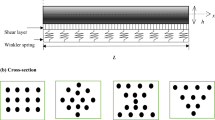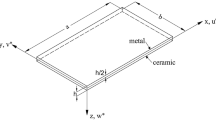Abstract
An efficient meshfree formulation based on the first-order shear deformation theory (FSDT) is presented for the static analysis of laminated composite beams and plates with integrated piezoelectric layers. This meshfree model is constructed based on the element-free Galerkin (EFG) method. The formulation is derived from the variational principle and the piezoelectric stiffness is taken into account in the model. In numerical test problems, bending control of piezoelectric bimorph beams was shown to have the efficiency and accuracy of the present EFG formulation for this class of problems. It is demonstrated that the different boundary conditions and applied actuate voltages affects the shape control of piezolaminated composite beams. The meshfree model is further extended to study the shape control of piezo-laminated composite plates. From the investigation, it is found that actuator patches bonded on high strain regions are significant in deflection control of laminated composite plates.
Similar content being viewed by others
Author information
Authors and Affiliations
Additional information
Received: 23 October 2001 / Accepted: 29 July 2002
Rights and permissions
About this article
Cite this article
Liew, K., Lim, H., Tan, M. et al. Analysis of laminated composite beams and plates with piezoelectric patches using the element-free Galerkin method. Computational Mechanics 29, 486–497 (2002). https://doi.org/10.1007/s00466-002-0358-3
Issue Date:
DOI: https://doi.org/10.1007/s00466-002-0358-3




